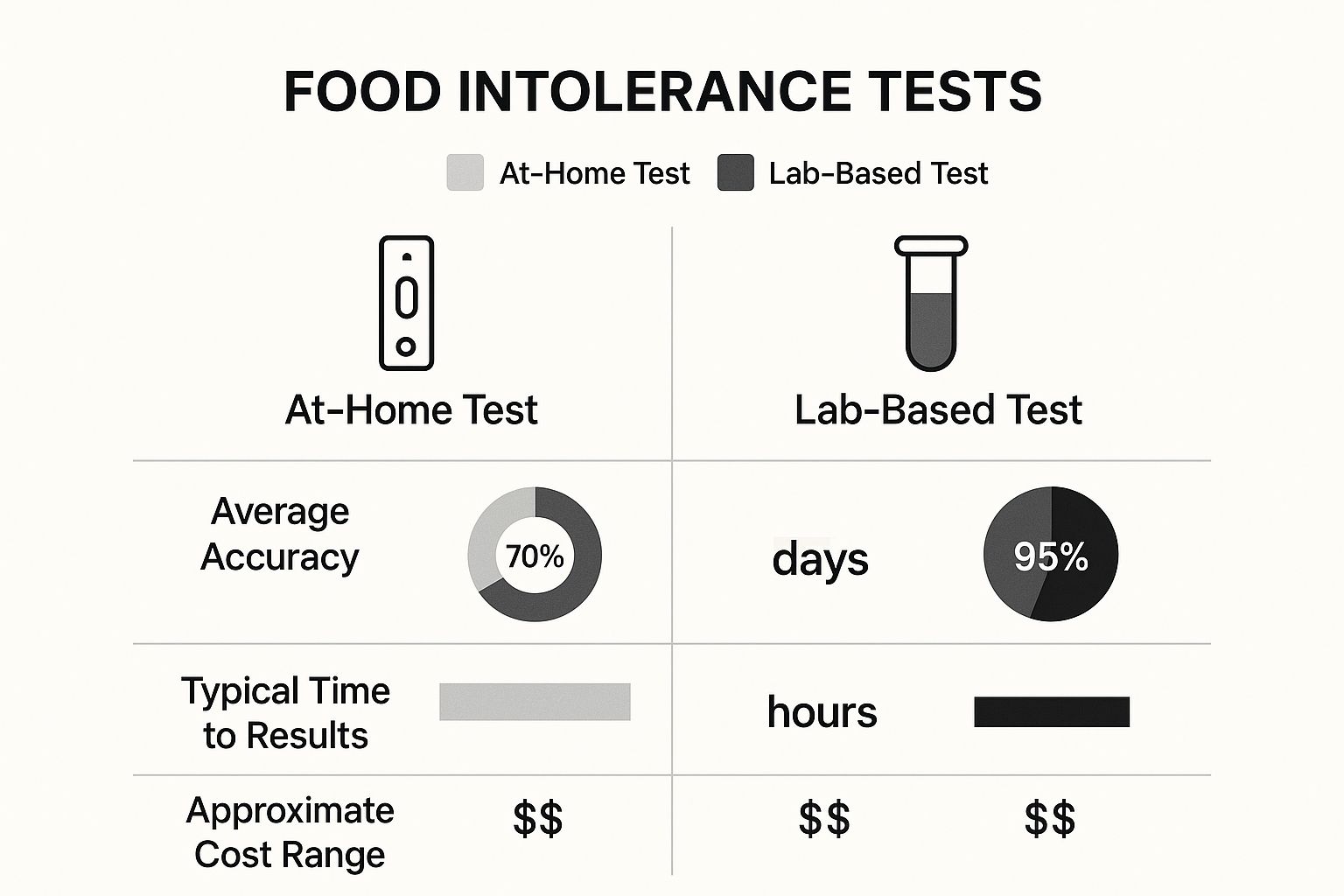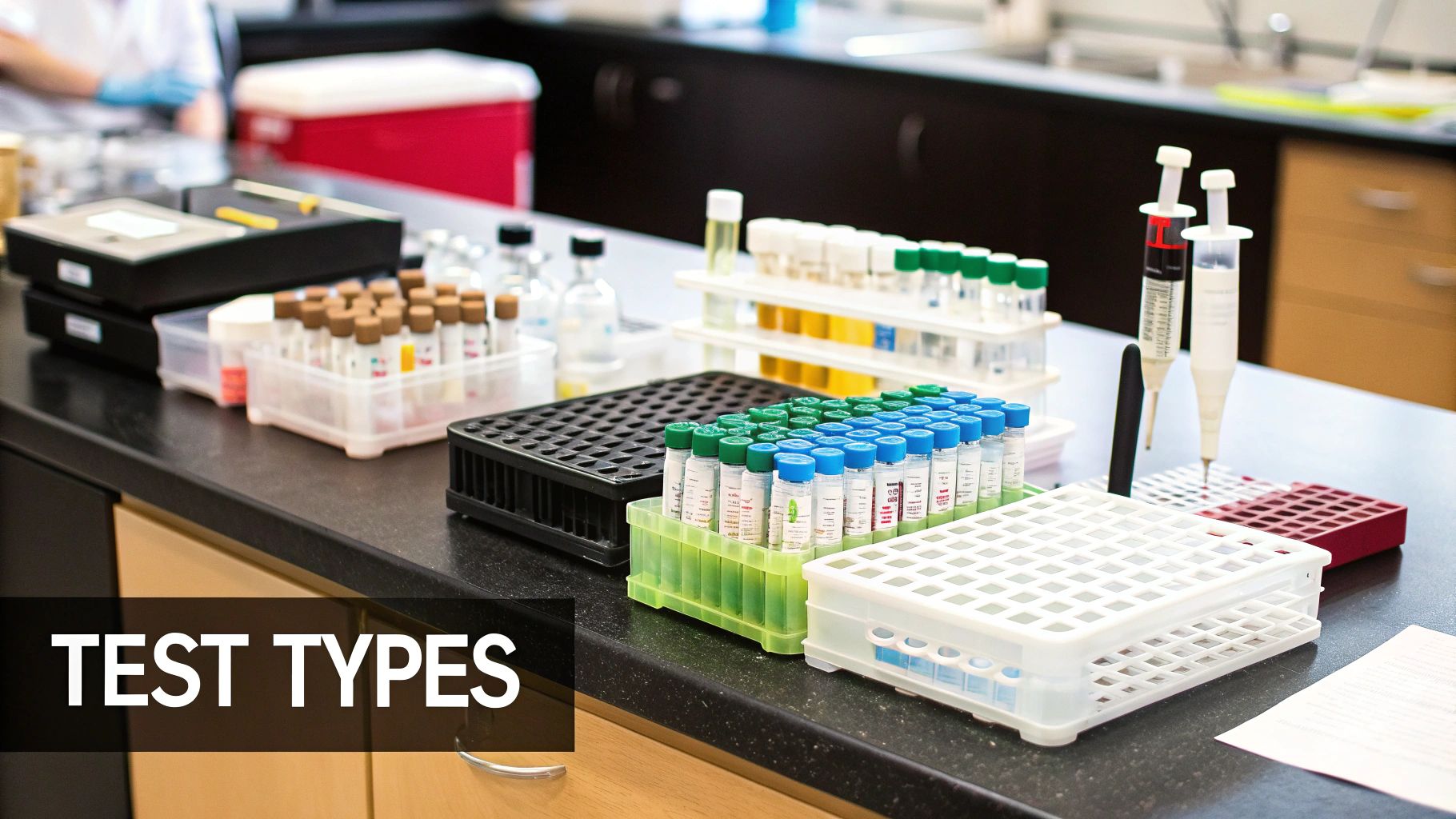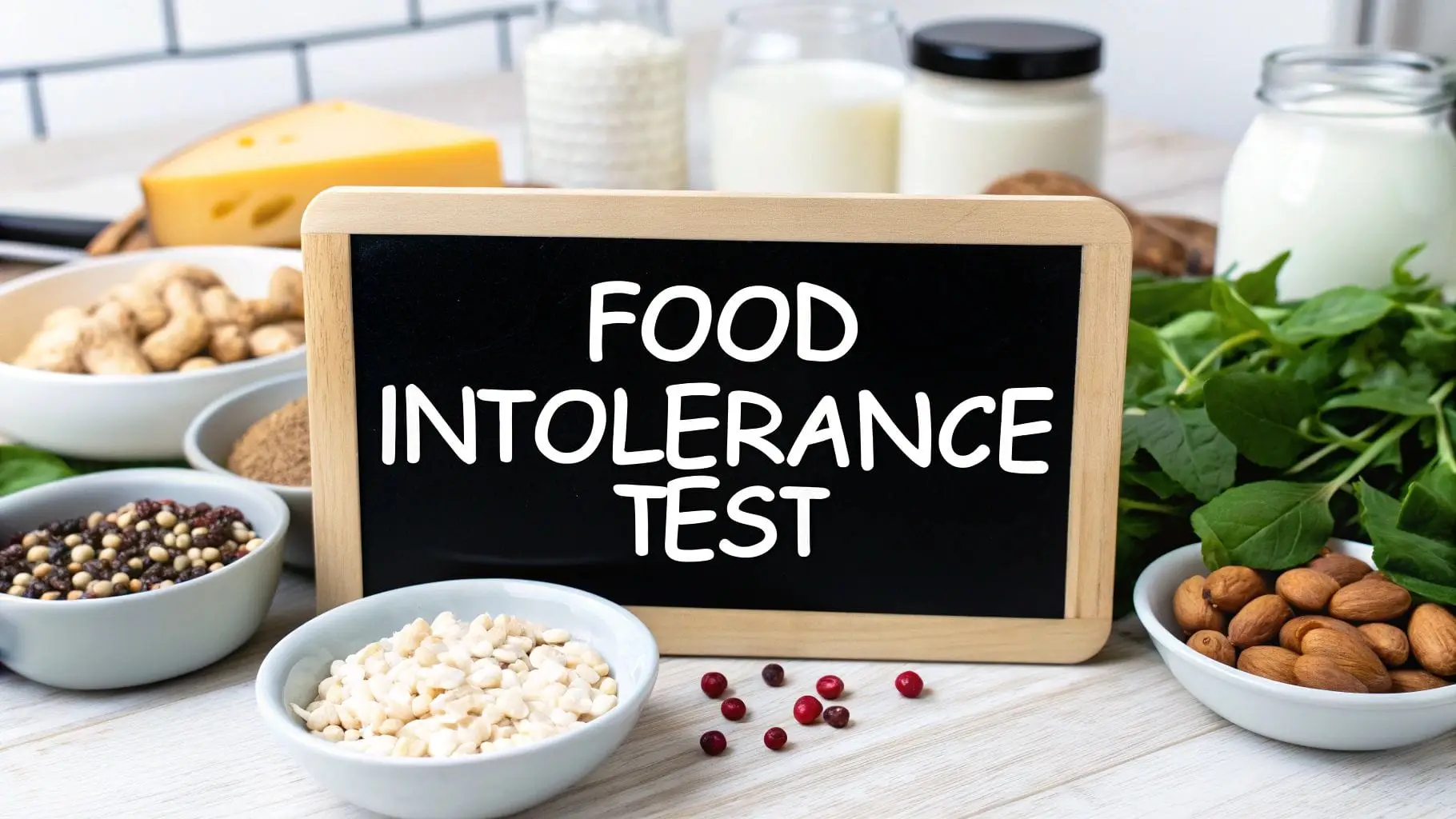Are you struggling with mysterious health issues like bloating, brain fog, or persistent fatigue? A food intolerance test could be the key to understanding why. This diagnostic guide helps identify specific foods that cause delayed, non-allergic reactions in your body. Unlike true allergies, which cause an immediate response, food intolerance symptoms can appear hours or even days after a meal, making them incredibly difficult to pinpoint on your own.
Decoding Your Body's Mysterious Signals

Do you ever feel bloated, foggy, or just plain "off" after eating but can't put your finger on why? You are definitely not alone. Many people deal with persistent, confusing symptoms that disrupt their daily lives—from nagging headaches and skin rashes to unpredictable digestive issues.
These mysterious signals are often your body’s way of saying that something you ate isn't sitting right. Think of your body as a high-performance car. If you put the wrong type of fuel in the tank, it won't break down immediately, but it will start running poorly. You’ll notice it sputtering, losing power, and just not operating as it should. A food intolerance works the same way, creating low-grade, chronic inflammation that can lead to a host of health problems.
Intolerance vs. Allergy: What Is the Difference?
It’s crucial to get the terms straight, because "intolerance," "sensitivity," and "allergy" are often used interchangeably, but they mean very different things. Understanding the distinction is the first step toward getting the right help.
- Food Allergy: This is an immediate and potentially life-threatening immune system response (mediated by IgE antibodies). Your body wrongly identifies a food protein as a major threat and unleashes chemicals like histamine. This causes reactions like hives, swelling, or trouble breathing. This is the car's alarm system blaring at full volume.
- Food Intolerance: This is primarily a digestive system issue. It happens when your body lacks the enzyme to break down a food component, like the lactose in milk. The reaction is delayed, uncomfortable, and usually centered in your gut. This is the engine running badly on the wrong fuel.
- Food Sensitivity: This term usually describes a delayed immune reaction (often involving IgG antibodies) that isn't a true allergy. It leads to less severe, often chronic symptoms like fatigue or joint pain.
While different, these issues are all common health concerns. Regional studies give us a glimpse of the scale; for example, research in Morocco showed that 9.5% of patients surveyed reported food allergies, while a Nigerian study found 28% of people self-reported allergies to common foods like seafood and legumes. These numbers show that adverse food reactions are a significant public health issue. You can learn more about these regional food allergy trends in this detailed study.
A food intolerance test acts like a diagnostic scan for your "engine," helping you pinpoint exactly which "fuels" are causing performance issues. It provides a data-driven starting point to finally connect your symptoms to your diet.
By uncovering your specific trigger foods, you can stop guessing and start knowing for sure. This knowledge is the key to creating a personalized eating plan that helps you feel your absolute best, restoring your energy and mental clarity. A food intolerance test isn't just about what to avoid; it's about discovering your path back to well-being.
Choosing the Right Food Intolerance Test for You
Trying to figure out which food intolerance test is right for you can feel overwhelming. With so many options available, all promising to give you the answers you need, it’s easy to feel lost. The most important step is understanding what each food intolerance test actually measures and how it aligns with your symptoms and health goals.
From blood tests that check your immune response to breath tests that analyze how you digest certain sugars, every method offers a different piece of the puzzle. Making an informed choice means you're more likely to get clear, actionable results that genuinely improve how you feel.
Understanding IgG Antibody Tests
One of the most common methods is the IgG (Immunoglobulin G) antibody test. The science behind it is straightforward: it measures the levels of IgG antibodies your immune system produces in response to specific food proteins. Think of these IgG antibodies as your body's "memory cells" for delayed reactions.
This differs from an instant allergic reaction, which is driven by IgE antibodies. An intolerance reaction can creep up on you, taking hours or even days to manifest as symptoms like bloating, headaches, or that nagging fatigue you can't shake. An IgG test screens a small blood sample against hundreds of food proteins to see which ones might be triggering this low-grade, delayed immune response.
An IgG food intolerance test provides a personalized "watchlist" of foods that could be contributing to chronic inflammation. It offers a data-driven starting point for an elimination diet, taking much of the guesswork out of finding your trigger foods.
This approach is particularly helpful for uncovering sensitivities to everyday foods—the ones you eat often and are hardest to connect to your symptoms on your own.
Comparing Key Testing Methods
While IgG tests are popular for their comprehensive scope, they aren’t your only option. Other important methods include the elimination diet and the hydrogen breath test, each with a specific purpose.
- Elimination Diet: Often called the "gold standard" for confirming food intolerances, this method involves removing suspected trigger foods from your diet for a period (usually 2-4 weeks). You then reintroduce them one by one to monitor your reaction. It’s highly effective but demands significant patience, discipline, and careful record-keeping.
- Hydrogen Breath Test: This is a specific diagnostic tool used by gastroenterologists to identify intolerances to sugars like lactose (from dairy) or fructose (from fruit). After drinking a sugar solution, the test measures the hydrogen on your breath. High levels indicate your body isn't breaking down that sugar properly.
To help you decide, here's a practical comparison:
A Practical Comparison of Food Intolerance Tests
This table breaks down the most common testing methods, weighing factors like accuracy, cost, and convenience to help you choose the best fit for your needs.
| Testing Method | What It Measures | Pros | Cons |
|---|---|---|---|
| IgG Antibody Test | IgG antibody levels in response to various food proteins. | Provides a comprehensive overview of potential sensitivities; great starting point. | Results require interpretation and confirmation; not a definitive diagnosis. |
| Elimination Diet | Your body's direct reaction to specific foods. | Considered the most accurate ("gold standard") method for confirmation. | Requires significant time, discipline, and meticulous tracking; can be difficult. |
| Hydrogen Breath Test | Malabsorption of specific sugars (e.g., lactose, fructose). | Highly accurate for specific sugar intolerances; a clear diagnostic tool. | Limited scope; only tests for one type of sugar at a time. |
Each method has its place, and the most effective approach often combines insights from more than one.
The infographic below helps visualize the key trade-offs between at-home tests and those done in a traditional lab.

While lab tests often have an edge in accuracy, at-home kits excel in convenience and speed, making them a practical first step for many people.
Making the Best Choice for You
So, how do you decide? The right food intolerance test depends on your individual situation. If you suspect a specific problem like lactose intolerance, a hydrogen breath test is the most direct way to get a clear answer. If you're dealing with vague, widespread symptoms and want a broad overview of potential culprits, an IgG test is an excellent starting point.
Ultimately, the best way to confirm any test's suggestions is with a carefully managed elimination diet. Using test results to guide a more focused elimination plan gives you the best of both worlds: scientific data to point you in the right direction and real-world evidence from your own body.
For a deeper dive into the options available, take a look at our complete guide on getting a food intolerance test in Dubai. It will help you choose the right path to finally understanding what your body is trying to tell you.
The Convenience of an At-Home Food Intolerance Test Kit

Taking charge of your health has never been easier. The rise of at-home food intolerance test kits puts powerful insights directly into your hands, breaking down barriers to understanding your body's complex reactions to food.
Forget about scheduling appointments and traveling to a clinic. You can now uncover potential dietary triggers from the comfort and privacy of your home. This major shift empowers you to take a proactive role in your wellness journey, on your own schedule.
How At-Home Testing Works
The process is designed to be incredibly simple and user-friendly, allowing anyone to do it with confidence. It transforms a once-complicated diagnostic journey into a few manageable steps.
- Order Your Kit: First, you choose and order a reputable test kit online. It arrives discreetly at your doorstep.
- Collect Your Sample: Using a small, sterile lancet included in the kit, you’ll collect a few drops of blood from a quick finger prick. It’s fast and virtually painless.
- Mail It Back: You then place the sample into the pre-paid return mailer and send it off to a certified laboratory for analysis.
- Receive Your Results: In about two weeks, you’ll get a comprehensive digital report via email, detailing your body’s reactivity to dozens of different foods.
This streamlined approach eliminates the need for a clinic visit for the initial sample collection, making it a perfect fit for busy lifestyles.
The Key Benefits of Home Testing
The appeal of an at-home food intolerance test goes beyond just skipping a trip to the doctor’s office. It’s a combination of advantages that aligns with a modern, hands-on approach to health management.
- Unmatched Convenience: Perform the test whenever and wherever works for you, without rearranging your work or family life.
- Complete Privacy: Your health is personal. At-home testing lets you manage the entire process discreetly, from sample collection to reviewing results.
- Empowerment Through Knowledge: Gaining direct access to data about your body provides a real sense of control. It equips you to make smarter, more informed dietary decisions.
This growing demand is reflected in market data. In the Middle East and Africa, the food intolerance testing market is projected to grow from USD 57.87 million in 2024 to nearly USD 71 million by 2029. This boom is fueled by greater awareness of how common foods like cow's milk, peanuts, and wheat can trigger uncomfortable conditions.
Addressing Questions on Accuracy
It's natural to question if an at-home test can be as reliable as one performed in a clinic. The key is the laboratory. While you collect the sample at home, the analysis happens in the same certified laboratories that process tests from doctors' offices.
Your at-home sample receives the same rigorous, professional analysis as any other. The technology and scientific standards are identical, ensuring that the convenience of home collection does not compromise the quality of your results.
These labs use advanced technology to precisely measure your IgG antibody responses, giving you a trustworthy foundation for your health journey. For those in Dubai seeking more diagnostic services without leaving home, exploring options for a comprehensive lab at home in Dubai can be a fantastic next step. At-home testing bridges the gap between curiosity and action, making it easier than ever to start decoding your body’s signals.
How to Prepare for Your Test for the Most Accurate Results
Getting the most accurate results from your food intolerance test begins long before you collect the sample. Just as a chef preps ingredients before cooking, the preparation you do beforehand significantly impacts the final outcome. Taking a few simple steps in the weeks leading up to your test ensures the data you receive is a true reflection of your body's current state.
This guide will clarify any confusion and help you approach your test with confidence, knowing you've done everything right to get reliable data about your health.
Eat a Varied Diet Before Testing
It may sound counterintuitive, but now is not the time to start eliminating foods from your diet. For an IgG test to detect a reaction, your body must have been recently exposed to the food. If you haven't eaten a potential trigger food in months, your IgG antibody levels could be too low for the test to detect, resulting in a false negative.
For at least four weeks before your test, maintain your normal, varied diet. In fact, make an effort to include a wide range of food groups, including those you suspect might be causing issues. This gives your immune system a chance to produce the antibodies the test is designed to measure, creating a complete and accurate picture for you.
Your test results are a snapshot of your body's current state. By eating a diverse diet beforehand, you ensure that snapshot captures everything, with no potential triggers hiding in the shadows.
What to Avoid for Clear Results
While a mixed diet is essential, there are a few things to avoid to prevent skewed results. Certain medications and habits can interfere with your immune response or hydration, affecting sample quality and test accuracy.
Here’s a quick checklist to keep in mind:
- Immunosuppressant Medications: Drugs designed to lower your immune system's activity, such as steroids, can directly reduce antibody production. This could interfere with the test's ability to detect sensitivities. Always consult your doctor before stopping any prescribed medication.
- Antihistamines: While these primarily target allergic reactions (involving IgE antibodies), some health professionals suggest pausing them for a few days before your test as a precaution.
- Dehydration: This is a critical factor, especially for a finger-prick blood test. Being well-hydrated ensures good blood flow, making sample collection much easier and faster. Drink plenty of water in the 24 hours before your test.
- Strenuous Exercise: A hard workout right before collecting your sample is not ideal. Intense physical activity can temporarily affect your hydration and other biomarkers.
By following these simple preparation steps, you are setting yourself up for success. You'll provide the lab with the best possible sample, and in return, you’ll receive the clearest, most helpful insights into your health.
Turning Your Food Intolerance Test Results Into an Action Plan

Your food intolerance test report has arrived. It's the moment of truth—a page full of data-driven clues about your diet. But staring at a list of foods with colored bars next to them can feel a bit daunting. What does it all mean, and more importantly, what should you do now?
Think of your report not as a final diagnosis but as a personalized roadmap. It highlights potential trouble spots in your diet, giving you a clear direction to start your journey toward feeling better. The next step is to translate this map into a simple, sustainable action plan.
Understanding Your Reactivity Levels
Your report will likely group foods into categories based on your body’s IgG antibody response. While the labels may vary, they usually follow a simple traffic light system to indicate high, borderline, or low reactivity.
- High Reactivity (Red): These are your primary suspects. Your body showed a strong IgG response, suggesting they are very likely contributing to your symptoms.
- Borderline Reactivity (Amber): These foods triggered a moderate response. They might be causing issues, especially if eaten frequently or in large quantities.
- Low Reactivity (Green): Good news! Your body showed little to no reaction. These foods are generally considered "safe" and can form the foundation of your diet moving forward.
This type of structured data is becoming increasingly vital as people seek to understand their bodies. The wider food safety testing market, which includes intolerance testing, is projected to grow at a CAGR of around 5.62% between 2022 and 2027. This trend reflects a major consumer shift toward food transparency, making tools like a food intolerance test essential for personal health management. You can discover more insights about the Middle East and Africa food safety testing market and its upward trend.
Creating Your Elimination Diet Roadmap
With your high-reactivity foods identified, the most effective next step is a temporary elimination diet. This isn’t about punishment or lifelong restriction; it’s a short-term investigation to confirm how these foods affect you in the real world.
An elimination diet is your opportunity to press the 'reset' button on your system. By removing the potential triggers your test identified, you give your body a chance to calm inflammation and begin to heal.
The process is straightforward. For about four to six weeks, you’ll completely remove all foods from your "red" list. It’s also wise to remove or significantly reduce foods from your "amber" list during this initial phase. This clean slate allows your body to recover, often leading to noticeable improvements in just a couple of weeks.
From Data to Daily Meals
Putting your report into action is about being practical. It’s not just about what you eliminate, but also about what you embrace. Focus on building meals around your long list of "green" light foods.
Here’s a simple strategy to get started:
- Plan Your Shopping: Make a list of all your non-reactive foods. This helps you focus on abundance, not restriction.
- Find Simple Swaps: If cow's milk is a high-reactivity item, explore alternatives like almond, oat, or coconut milk. If wheat is a problem, try gluten-free grains like quinoa or brown rice.
- Read Labels Diligently: Trigger ingredients can hide in unexpected places like sauces, soups, and processed snacks. Become a careful label reader to avoid accidental exposure.
This process of elimination and observation is a powerful step in taking control of your well-being. It pairs perfectly with other proactive health measures, like getting a full body check-up, to create a holistic view of your health. Your food intolerance test report is the first chapter, giving you the essential clues to write your own story of improved health.
Why Your Doctor Is Your Most Important Ally After a Test
An at-home food intolerance test provides a fascinating look at how your body might be reacting to certain foods. Think of it as a detailed map of your potential dietary triggers. But having a map is one thing; knowing how to read it and navigate the terrain is another. That’s where your doctor comes in.
Professional medical guidance is what transforms raw data into a safe, effective plan for feeling better. While your test report can flag potential problem foods, a doctor provides the crucial context that a piece of paper simply cannot.
A Holistic View of Your Health
Your doctor doesn't just see a list of foods. They see you—your entire health profile. They can interpret your food intolerance results alongside your medical history, current symptoms, and any other health conditions you may have. This comprehensive view is essential for an accurate interpretation.
What appears to be a food intolerance could be a symptom of something else. For instance, conditions like irritable bowel syndrome (IBS) or celiac disease can cause similar symptoms, such as bloating and abdominal pain.
A doctor is the only professional qualified to rule out more serious medical issues before you overhaul your diet. This step is critical to ensure you’re treating the root cause of your symptoms, not just a secondary problem.
Designing a Safe and Balanced Diet
After receiving your results, the next logical step is often an elimination diet. However, cutting out entire food groups without a strategy can backfire. If you simply stop eating all dairy or wheat, you could easily develop nutritional gaps, missing vital nutrients like calcium, fiber, and B vitamins.
A doctor or registered dietitian can help you create an elimination plan that is both effective and nutritionally sound. They will help you find healthy, sustainable replacements for any foods you remove, ensuring your overall health doesn't suffer while you identify your triggers.
Here’s where having a doctor on your team makes a significant difference:
- Diagnostic Clarity: They can differentiate between a food intolerance, a true food allergy, and other digestive disorders, which is key for a correct diagnosis.
- Nutritional Safety: They will help you craft a balanced eating plan that prevents nutrient deficiencies during the elimination phase.
- Structured Reintroduction: When it's time, they can guide you on how to reintroduce foods methodically and safely to properly test your body's response.
Your family doctor is often the best person to coordinate this. Understanding how general physician services act as your first line of defense is a huge asset in managing your overall health. Partnering with your doctor transforms your test results from interesting information into a powerful, safe, and actionable roadmap to feeling your best.
Common Questions About Food Intolerance Testing
Embarking on food intolerance testing is a proactive step toward understanding your body, but it's natural to have questions. This section provides clear, straightforward answers to the most frequently asked questions, helping you move forward with confidence.
How Soon Will I See Results from Diet Changes?
This is often the first question on everyone's mind. The answer varies from person to person. Many people report feeling initial improvements—such as reduced bloating, clearer thinking, and calmer digestion—within the first two to four weeks of eliminating their trigger foods.
However, more significant and lasting changes often take longer, typically around three months. This period gives your body sufficient time to reduce chronic inflammation and allow your gut to heal. The single most important factor for success is consistency.
Will I Have to Avoid These Foods Forever?
Probably not, and this is a key difference between a food intolerance and a true food allergy. Intolerances are not always permanent. They can sometimes improve or even resolve completely, especially after giving your digestive system a much-needed break.
After an initial elimination period of three to six months, you may be able to slowly reintroduce some of these foods in moderation without a reaction. Working with a healthcare professional is the safest way to do this, as they can help you create a structured reintroduction plan to test what your body can handle.
Can This Test Help with Weight Management?
While a food intolerance test is not designed as a "weight-loss test," it can be a valuable tool in your weight management journey. The low-grade, chronic inflammation caused by reactive foods can interfere with your metabolism and hormonal balance, making it more difficult to maintain a healthy weight.
By removing these inflammatory triggers, you help your body function more efficiently and improve digestion. This process also encourages more mindful eating habits, which often leads to achieving and maintaining a weight that is healthy for you.
What Is an IgG Test Compared to an IgE Test?
The easiest way to understand the difference is by speed and severity of the reaction. An IgE (Immunoglobulin E) test is used by doctors to identify a true food allergy. This involves an immediate, sometimes severe, immune reaction that can occur within minutes of eating the offending food.
On the other hand, an IgG (Immunoglobulin G) test, which is used for food intolerances, detects a much slower and more subtle reaction. These delayed responses can take hours or even days to manifest as symptoms, making them nearly impossible to connect to a specific food without testing.
If you suspect you are experiencing immediate reactions, it's crucial to explore all diagnostic possibilities. To learn more, check out our guide on getting an allergy test in Dubai to better understand the different diagnostic routes available.
Ready to get clear answers and take control of your health? Call To Doctor offers convenient at-home food intolerance testing to help you identify your unique dietary triggers without the hassle. Book your test today and start your journey toward feeling your best.



Leave a Reply